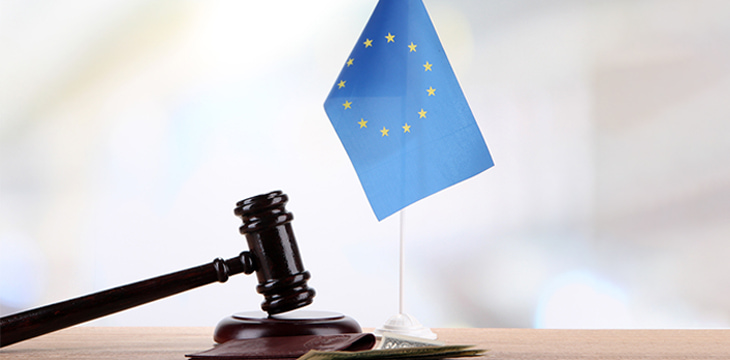|
Getting your Trinity Audio player ready...
|
Like a horror movie villain that just won’t die, European legislators just won’t stop coming up with new ways to thwart the ambitions of “crypto” bros.
Members of the European Parliament are reportedly considering a new draft of anti-money laundering (AML) and combatting the financing of terrorism (CFT) laws that would cover a raft of digital asset transactions by European Union (EU) residents. The sectors potentially put under the AML/CFT microscope include decentralized finance (DeFi) platforms, the decentralized autonomous organizations (DAOs) that govern DeFi operations, and entities operating Web3 companies.
The new draft is being framed as “compromise amendments” to the broader plan to update the EU’s AML/CFT laws that have been in the works for over a year. Non-fungible tokens (NFTs) were put squarely in the EU’s crosshairs in July, but the individuals behind DeFi/DAO operations are now sweating the realization that they, too, aren’t exempt from oversight.
The draft text warns DeFi “developers, owners or operators” that they need to properly “assess risks” before “launching or using a software or platform.” The text seeks to apply existing AML/CFT rules to DeFi transactions if they’re “controlled directly or indirectly, including through smart contracts or voting protocols, by natural and legal persons.”
Back in July, the European Central Bank (ECB) issued a bulletin that poked holes in the myth of DeFi decentralization, stating that “in reality, governance is often concentrated” and “DeFi applications retain a high level of centralization.” (As our own Joshua Henslee has observed, it’s all decentralized until someone gets rekt.)
The European Parliament’s draft text also warns that Web3 companies could be exploited by unscrupulous actors looking to launder ill-gotten gains via transactions involving virtual real estate or other metaverse assets. The plan is to include Web3 firms alongside banks, diamond merchants, real estate brokers, and such on the list of entities that are obligated to monitor all transactions over €1,000 ($973.13).
The EU is advancing crypto oversight on a number of fronts, including the Markets in Crypto Assets (MiCA) regulations and the formation of a new Anti-Money Laundering Authority (AMLA) that would ensure a consistent continent-wide approach to tracking dodgy transactions.
But the process of aligning the wishes of the European Parliament, European Commission, European Council, and the EU’s other decision-making bodies has been likened to herding cats, and some finicky felines appear not at all eager to be corralled on crypto issues. For example…
Unstable reaction
Just last week, crypto bros were celebrating the leak of the latest MiCA draft that appeared to scrap proposed restrictions on transactions involving stablecoins pegged to fiat currencies other than the euro, such as Circle’s dollar-denominated USDC and Tether’s USDT. (Stablecoins denominated in euros, such as Circle’s new EUROC, appear to be in the clear.)
However, following protests from France’s central bankers, enough EU member states—reportedly including Germany, Italy, and the Netherlands—have been convinced to reinsert a €200 million ($194.6 million) daily cap on non-euro stablecoin transactions into the MiCA text.
Predictably, “crypto” backers are crying foul, arguing that the cap isn’t nearly high enough to guarantee zero disruptions to the rampant stablecoin-based wash trading that ensures the artificial “number go up” trajectory of most major digital tokens. Honestly, don’t those EU pols understand there are bags to dump here?
MiCA is expected to face a vote by the European Parliament’s Economic and Monetary Affairs committee in October or November, and there will undoubtedly be more furious lobbying and horse trading before that vote is cast. And ECB president Christine Lagarde has already called for a MiCA 2, so whatever happens over the next few months may prove only as permanent as the screen of an Etch-a-Sketch.
Trust Jeff Bezos … What could possibly go wrong?
Much of the EU’s stablecoin apprehension stems from fears that its central bank digital currency (CBDC) project might not be able to compete. The ECB is developing a “digital euro,” but the potential involvement of U.S. tech giant Amazon is raising red flags amongst EU politicians.
This week, ECB executive board member Fabio Panetta gave a speech to the Economic and Monetary Affairs committee on the importance of ensuring EU control over digital payments. However, committee members questioned why Amazon—the only non-EU firm of the five companies selected to help trial the digital euro’s potential—had been tasked with developing e-commerce application prototypes for the digital euro.
Committee members wondered if the company’s track record—it was fined €746 million ($725 million) last year for breaching EU privacy rules and recently threatened to quit the EU entirely to avoid additional penalties for violating anti-trust regulations—makes it a suitable partner for such a sensitive and important project.
Panetta attempted to mollify these concerns by claiming that Amazon was selected in part because it was the only company to apply for the e-com prototype job. But Panetta’s claim that Amazon received neither payment nor access to any data derived from the trials only sparked new questions as to why, without any apparent compensation, the notoriously cutthroat Amazon was so keen to participate.
At a different meeting this week, ECB advisor Jürgen Schaaf also sought to downplay concerns over Amazon’s involvement, saying the five companies involved were selected based on “technological consideration” alone.
Schaaf added that the results of the current “prototyping” phase—which is expected to conclude in Q1 2023—wouldn’t necessarily be fed directly into the ensuing “experimental” portion of the trials, suggesting that Amazon’s involvement might conclude when the current phase is over. The entire process is expected to take up to two years.
Schaaf also stated that Amazon’s participation is intended to signal that the digital euro won’t stop at the EU’s borders. Strengthening the EU’s “monetary autonomy with a digital euro does not mean that Europe would shut down all its gates for retailers from abroad.” The ECB’s Lagarde has similarly expressed hopes that a digital euro would find adoption outside the EU.
Watch: The BSV Global Blockchain Convention panel, Law & Order: Regulatory Compliance for Blockchain & Digital Assets

 12-25-2025
12-25-2025 




